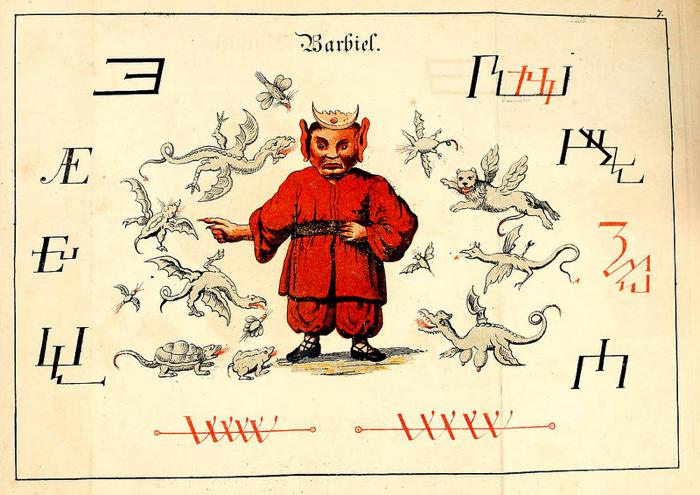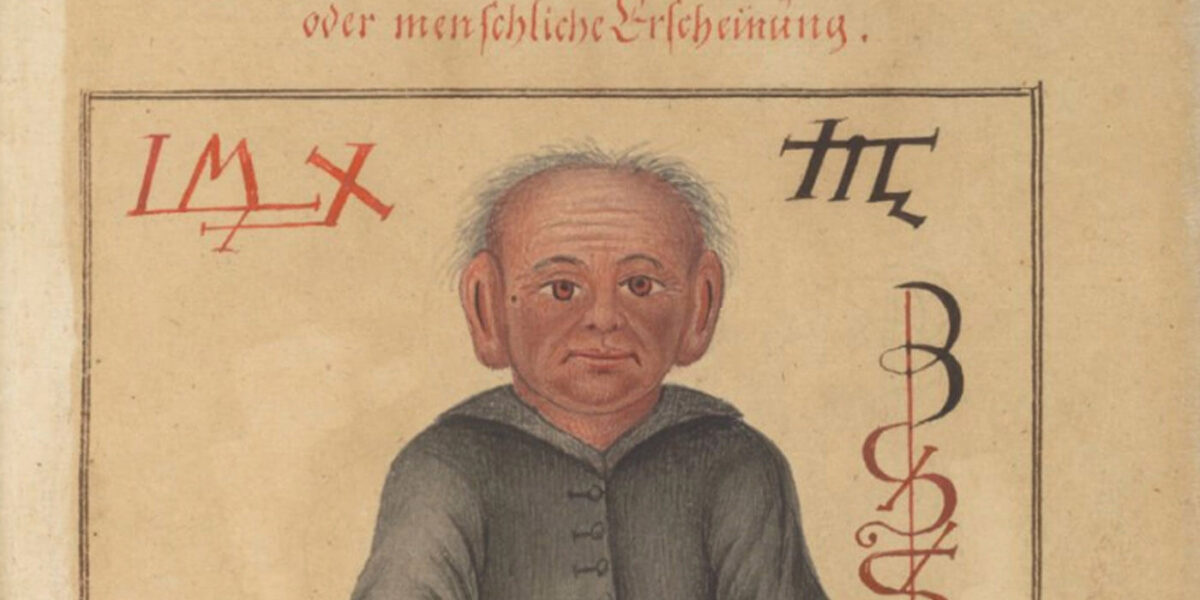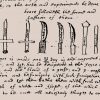oder Dreifacher Höllenzwang, letztes Testament und Siegelkunst nach einer kostbar ausgestatteten Handschrift in der Herzogl. Bibliothek zu Koburg vollständig und wortgetreu herausgegeben in fünf Abtheilungen, mit einer Menge illuminirter auf 146 Tafeln
by Johann Georg Faust, Stuttgart: Scheible, 1849
Dr. Johannes Faust’s Threefold Coercion of Hell is a German grimoire dedicated to art of coercing, binding and making obedient numerous spirits and demons. It is one of many textual variations of Faust’s Höllenzwang, a designation given to brand of black magic grimoires spuriously attributed to Johann Georg Faust, that although claiming to be from the middle ages, were created in the 17th, 18th or 19th centuries. The text is renowned for its numerous color illustrations, 146 in total. The rest consists of written prayers, conjurations and warnings, followed by descriptions of the spirits and ritual procedures.
It was first published by Johann Scheible in Stuttgart, 1849 although the text is much earlier. Upon close inspection, it was most likely derived from a manuscript written in Passau ca. 1612, mentioned in the letters of Goethe: Praxis cabulae nigrae doctoris Johannis Fausti … Magia naturalis et innaturalis oder unerforschlicher Höllenzwang.

Stuttgart: Scheible, 1849 
MS Cabulae Nigrae, 1612
Contents
Teufelskunst.com has created an amazing synopsis; the best i have read in English which i have reproduced below.
The main motif of the book is the “Harrowing of Hell”, the descent of Christ into hell, which is re-enacted by the practitioner. The spirits, such as Aciel, Anael and the tutelary Mephistophiel/ Mephistophiles, are illustrated in full color and their peculiarities pertaining to their different appearances and modes of calling and commanding are described in detail. In addition are given countless sigils for the spirits and circles, typically colored in black and red (a trademark of this book). The spirits are in fact demons, or fallen angels, who were once of heavenly origin, as is implied by the suffix “-el”. Noteworthy, the spirits are made to appear and manifest physically before the practitioner. Lengthy prayers to god and the arch-angels (called upon by hundreds of names) are given to protect the practitioner and camouflage the black-magical nature of the workings. The outlined ritual instructions are to be followed meticulously or the fool approaching these lightly will surely be damned
Before all else the practitioner is to enter a pact, in which the spirits are made to swear by their prince Lucifer, to obey everything, that is said and written within the pages of this book. The nature of the pact and how it is made is described in detail in the preface. Key tools are the rod, which is made of a long Juniper branch, the incense, containing I. frankincense, myrrh, mastic and aloes, II. pitch and sulfur, and III. Helleborus niger root, sulfur and garlic, and of course the magic circle, which turns out is a rather complex construction, but crucial for the workings and the only “safe” place for the practitioner.
The spirits named herein are demons of hell. The chief commander of all devils and king is called Nadanniel, who is also known as Lucifer, Bludohn and Beelzebub. Subordinate to him are seven grand dukes, 1) Barbiel ♄ 2) Mephistophiel ♃ 3) Gamael seu Apadiel 4) Aciel ☉ 5) Anael 6) Ariel ☿ 7) Marbuel ☽, which are listed according to their planetary attributions. To them are obedient seven counts, namely 1) Ahisdophiel 2) Camniel 3) Padiel 4) Coradiel 5) Osphadiel 6) Adadiel 7) Casphiel. These are followed by seven smaller counts, namely 1) Radiel 2) Dirachiel 3) Paradiel 4) Amodiel 5) Ischabadiel 6) Jazariel 7) Casadiel. These are again followed by seven barons, seven noble, seven peasant and seven intelligent spirits (noted to be especially quick), whereby the latter are named like the grand dukes, except for Anael, which is replaced by Camniel. They are followed by seven inane spirits, which are likely to enter into pacts but also easy to get rid of. All of the aforementioned are evoked by the citation and from within the circle of grand duke Barbiel (the Saturnian demon). By reciting a Barbiel formula the practitioner is also protected from all harm caused by iron, bullets, grenades or sharp weapons.
These are succeeded by four great liberal spirits, these being called Asmodiel (chief spirit of beheading and murder), Discerdiel (spirit of strife), Pamniel (spirit of thievery) and Amodiel (spirit of harlots). Then follow seven spirits of the liberal arts, namely Badon (teaches philosophy), Bidon (painting), Abdaph (surgery), Ibadon (astrology), Astromiel (mining), Aphiel (hunting) and Apidius (architecture).
The third part deals with various elemental spirits: seven greater and five lesser fire spirits, named Adiel, Amudiel, Kiriel, Azeruel, Ergediel, Abdicuel and Amediel, to whom are servient Geliel, Rumiel, Requiel, Aprinel and Tagriel. Then follow eight greater air spirits, namely Coradiel, Sumnidiel, Coachiel (teaches alchemy), Damniel, Barbiel, Adatiel, Pedartiel and Caffiel. The water spirits are ruled by Hydriel, to whom Martaliel, Lameniel, Camiel, Brachiel, Arbiel, Pesariel, Samiel, Lusiel, Musuziel, Dusiriel and Chariel are servitors. Hydriel appears as a gentle mermaid. These water spirits will report of and bring you anything, which has been sunken in their domain. Prince Buriel rules over the earth spirits and appears only at night. His arrival is accompanied by thunder and lightning, and extra precaution is required in his evocation, as he is described as a mean spirit, who hates and is hated by the other spirits. Buriel’s servitors are Merosiel, Casbriel, Drusiel, Almadiel, Nedriel, Carniel, Cupriel, Bufiel, Drubriel, Sarniel, Futiel and Natros. These are subordinate princes rather than common servitors.
Subordinate to Buriel are also the pygmies, which are amicable earth spirits, occurring as dwarfs. They are ruled by Buriel and king Urinaphton and enjoy the company of men. Peculiar for their evocation is the serving of a banquet, requiring a white linen cloth, to be sewed by a girl of 7 to 9 years age. Food and balmy incense have to be served.
The rest deals with alchemical operations and talisman making, such as the construction of an electrum, or “Fünde-Kugel”, a sphere made of a sevenfold metal-alloy. This sphere is a divinatory tool, used for finding treasures and mineral ores and also for telling right from wrong, exposing an imposter, protecting from harm, bringing back stolen goods, keeping away malign spirits and hexes, for exorcisms and even for bringing death. Other tools described are the earthen mirror and, the construction of a magic bell. Further operations include the extraction of crystals from metal or glass and various uses of mirrors and crystals.
The fourth part deals with necromancy and the spirits of the dead and ancestral spirits, who are ruled by Bazarachiel, who occurs as a white serpent. He is a mighty and all-knowing spirit, the first to make a pact with Satan and rules over all the wyrm and “unclean” animals. To understand his miracle is described as equivalent to being elected emperor by god.
Then are described the after spirits, Psohdon, Beulus, Laoobis, Nestorat, as well as other spirits, Abton, Asaron, Naraal, Agaton and Rartmaratarium, who mostly bring money, luck and treasures. Further instructions are given concerning the exorcism of a Poltergeist from a house, how to gain riches and receive messages from the spirits.
The fifth (and last part) deals with treasure digging and the creation and various uses of magical insignia and sigills, such as the seal of Salomon and the odd “Nasenzwang” of Lucifer. These are succeeded by elaborate seals for the arch angels, further Salomonic seals for treasure digging, as well as two special pentacles, one being a cross and the other the “secret Nasenzwang” of Lucifer. Then follow the seven seals and pentacles for the planetary rulers as well as more Salomonic sigils. Then follows a secret seal of the world and seven seals for the Olympian spirits, who are called Och, Bethor, Phalec, Aratron, Hagit, Ophiel and Phul, and further two seals derived from the new testament, namely one seal depicting Christ’s grave and the other the serpent seal of Moses with the Tau-cross in the center. The very last seals show the characters of Kunifer and Salmison as well as candle inscriptions. The former is to be written on birch bark. Kunifer is then forced to give answer to any question. The same is done for Salmison, but with a different parchment. The last working is conducted by Faust’s famulo, Christoph Wagner, who is to banish the spirit of a deceased from a treasure by the aid of the circle and a long conjuration and prayer for the treasure digger. Since the spirit of a dead is still attached to sought treasure, the operation likely involves the desecration of the grave of a rich man, to be forgiven by the father, the sun and the holy ghost. Amen




